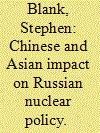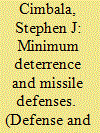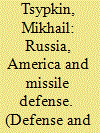| Srl | Item |
| 1 |
ID:
111883


|
|
|
|
|
| Publication |
2012.
|
| Summary/Abstract |
Asia, where nuclear powers already interact (including North Korea), exerts a growing influence on the thinking and policy underlying Russia's current and future nuclear (and overall defense) posture. China's rise is forcing Russia into a greater reliance on strategic offensive weapons and tactical nuclear weapons. These in turn will reinforce its opposition to US missile defenses, not only in Europe but also in Asia. Russia must now entertain the possibility of nuclear use in regional conflicts that would otherwise remain purely conventional. It cannot be postulated blindly that nuclear weapons serve no discernible purpose other than to deter nuclear attacks by other nuclear powers. The strategic equation in Asia and in the Russian Far East convincingly demonstrates the falsity of this approach. Nuclear weapons will be the essential component of Russia's regional defense policy if not of its overall policies - and this also includes contingencies in Europe.
|
|
|
|
|
|
|
|
|
|
|
|
|
|
|
|
| 2 |
ID:
111881


|
|
|
|
|
| Publication |
2012.
|
| Summary/Abstract |
Conventional wisdom seems to hold that under Barack Obama, the US ballistic missile defence programme has been pushed aside to allow for a refreshed domestic and international agenda. Proponents point to Obama's campaign thinking and rhetoric, the ballistic missile defence (BMD) budget cuts, the decision to end the Third Site in Europe, and the reset relations with Russia through the New Strategic Arms Reduction Treaty (New START) as evidence that the programme has undergone a significant period of change, retraction and rationalisation. This article argues instead that BMD has not fallen from prominence and that there is a change in focus rather than retraction of its strategic goal. Consequently, BMD continues to grow in importance as a component of US national security strategy.
|
|
|
|
|
|
|
|
|
|
|
|
|
|
|
|
| 3 |
ID:
111885


|
|
|
|
|
| Publication |
2012.
|
| Summary/Abstract |
Minimum deterrence is a compromise, or halfway house, between nuclear abolition or nearly zero and assured destruction, the dominant paradigm for strategic nuclear arms control during and after the cold war. Minimum deterrence as applied to the current relationship between the United States and Russia would require downsizing the numbers of operationally deployed long-range nuclear weapons to 1000, or fewer, on each side. More drastic bilateral Russian-American reductions would require the cooperation of other nuclear weapons states in making proportional reductions in their own arsenals. In addition, US plans for European-based and global missile defenses cause considerable angst in Russia and threaten to derail the Obama "reset" in Russian-American relations, despite the uncertainties about current and plausible future performances of missile defense technologies.
|
|
|
|
|
|
|
|
|
|
|
|
|
|
|
|
| 4 |
ID:
111882


|
|
|
|
|
| Publication |
2012.
|
| Summary/Abstract |
In 2009, the Obama administration announced a new missile defense strategy, termed a phased-adaptive architecture (PAA) focused primarily on countering the growing threat from theater ballistic missiles. The success of this strategy is predicated on the rapid development and fielding of successive increments of defensive capability in a manner adapted to the specific requirements for missile defenses in different regions of the world. The administration is committed to building a European regional missile defense system, the European PAA or EPAA between now and 2020. The first elements of the EPAA were deployed in late 2011. However, much progress is still required in order to reach the goals set for the PAA. This article addresses the technological, operational and political issues confronting the Obama administration in its efforts to make the PAA a reality.
|
|
|
|
|
|
|
|
|
|
|
|
|
|
|
|
| 5 |
ID:
111886


|
|
|
|
|
| Publication |
2012.
|
| Summary/Abstract |
In the past, terrorists have tended to eschew acts of extreme violence for fear of alienating those whom they wish to persuade and attract to their cause. The first to discard this philosophy was the Aum group in Japan, which sought to use anthrax and acquire a nuclear weapon. Since then, attitudes have changed, spurred on by the impact on public perception of the successful Al Qaeda 9/11 attack on New York and Washington. By crossing the line between moderation and extreme violence, terrorist groups retain one valuable capability: they are much less easily deterred and have few inhibitions. This article considers the three nuclear options open to terrorists - produce a radiological contaminant bomb; build a nuclear bomb; or steal or get given a nuclear device. It examines the possibilities and probabilities of each option and considers how the implementation of the Nuclear Non-proliferation Treaty (NPT) provisions might impose some constraints on terrorists' nuclear ambitions. By examining the doubtful nuclear security practices of different states and providing statistical evidence of an increase in levels of international terrorist violence, this article points to determined terrorists in time acquiring the means to acquire one or other variants of a nuclear weapon. It concludes that it is not a matter of "if" but "when."
|
|
|
|
|
|
|
|
|
|
|
|
|
|
|
|
| 6 |
ID:
111884


|
|
|
|
|
| Publication |
2012.
|
| Summary/Abstract |
Russia has sharply objected to US plans for ballistic missile defense. The Russian official explanation is that the real purpose of the US missile defense plan is to make it impossible for Russia to retaliate against a US nuclear (or massive conventional) attack, thus making Russia subject to military blackmail by the US. The Russian response has been the result of a sum total of various factors, mostly political and cultural, while the technical capabilities of the proposed system have played a secondary role.
|
|
|
|
|
|
|
|
|
|
|
|
|
|
|
|